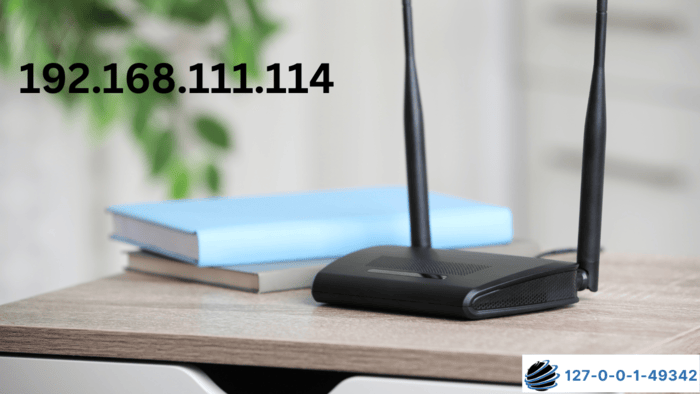Most homes with internet use a router to create a Wi-Fi network. You likely connected the router and set up a basic network. However, the default settings are often not secure or optimized. Your network might not have a password or may not suit your needs.
To modify these settings, log in to your router using 192.168.111.114. Even if a professional or your ISP configured it, you may still need to access 192.168.111.114 to troubleshoot issues. Knowing how to reach your router’s admin page is essential and more straightforward than it sounds.

Steps to Access 192.168.111.114
- Prepare Your Device: Use a smartphone, computer, or laptop with internet access. Connect the device to the router, either via Wi-Fi or with an Ethernet cable.
- Open a Browser: Launch your preferred browser—Chrome, Firefox, Edge, or Safari. Type 192.168.111.114 into the address bar.
- Log in to the Router: The IP address will take you to the router’s login page. Enter the username and password. If you’ve never changed these details, check the label on your router or visit the manufacturer’s website for the default credentials. If you changed them but forgot to do so, reset the router to restore the default login details. Remember, resetting will erase all custom settings.
Adjusting Router Settings
Once you access the admin page, you can modify your router’s settings.
Update Login Details
- Navigate to the general settings menu.
- Select the option to change the router password.
- Enter a new, secure password that you can remember.
- Save the changes. (You can also change the username in the same menu.)
Change the Local IP Address
- Open the general or network settings menu.
- Select the “router settings” option.
- Replace 192.168.111.114 with your desired IP address.
- Save your changes.
Customize Wi-Fi Network Details
- Open the wireless settings menu on the admin page.
- Update the SSID (network name) by entering your preferred name.
- Save the changes.
To change the Wi-Fi password:
- Stay in the wireless settings menu.
- Locate the password field.
- Enter a new password.
- Save your changes.
More About 192.168.111.114
Your router uses the private IP address 192.168.111.114 to manage data requests from devices connected to your network. This address lets your router send and receive information between devices and the internet.
Routers also have public IP addresses, which websites and your ISP use to deliver data back to your router. The router transfers the data to your device using the private IP address.
How to Find Your IP Address
You might not have 192.168.111.114 as your router’s IP address. Search for your router model online or check its manual to find the correct address. You can locate the IP address directly from your computer if you still can’t find
Windows:
- Click the network icon at the bottom-right corner of your screen.
- Choose your connected Wi-Fi network.
- Look for IPv4 in the details. The numbers next to it are your IP address.
For macOS:
- Open the Apple menu.
- Go to “System Preferences.”
- Select the network you use for internet access.
- Check the IP address listed next to “Router.”
If someone changes your router’s private IP address from the default, you can reset it to factory settings. Keep in mind that this will also erase other configurations.
What Is 192.168.111.114?
The private IP address 192.168.111.114 helps your router identify itself on your network. It acts as the delivery point for data requests from connected devices. Manufacturers often assign similar private IP addresses to their routers, so 192.168.111.114 is not unique.
Every device on your network has its private IP address. These IPs allow devices to communicate with each other and the router. Non-internet devices like printers also have private IPs. Usually, devices on your network have IPs that are variations of the router’s address, with the last number changed.
IPv4, the most common system for IP addresses, uses four numbers such as 20.0.0.1, 127.0.0.1 in 127.0.0.1:62893, etc. The Internet Assigned Numbers Authority (IANA) reserves specific ranges for private IP addresses:
- 10.0.0.0 to 10.255.255.255
- 172.16.0.0 to 172.31.255.255
- 192.168.0.0 to 192.168.255.255
These ranges include about 18 million private IPs. Manufacturers usually select a few from these ranges for their routers.
Private vs. Public IP Addresses
Your router uses the private IP address 192.168.111.114 for your local network. It also has a public IP address, which your ISP assigns. Public IPs connect your router to the internet and enable communication with websites.
Unlike private IPs, public IPs often change. ISPs assign dynamic public IPs temporarily and reassign them when a user disconnects. Static public IPs, however, remain constant and are typically used by servers and websites.
Websites can see your public IP address and use it to estimate your location. Hackers can exploit public IPs to gather personal information. You can use a VPN to hide your public IP to improve security. VPNs replace your actual IP with another, often showing a different location. Some routers include built-in VPN features for added protection.
Final Notes
Following these steps, you can secure and customize your router and Wi-Fi network. Explore additional options, like optimizing the network or enabling parental controls, to improve your setup. Permanently save your settings after making changes.
